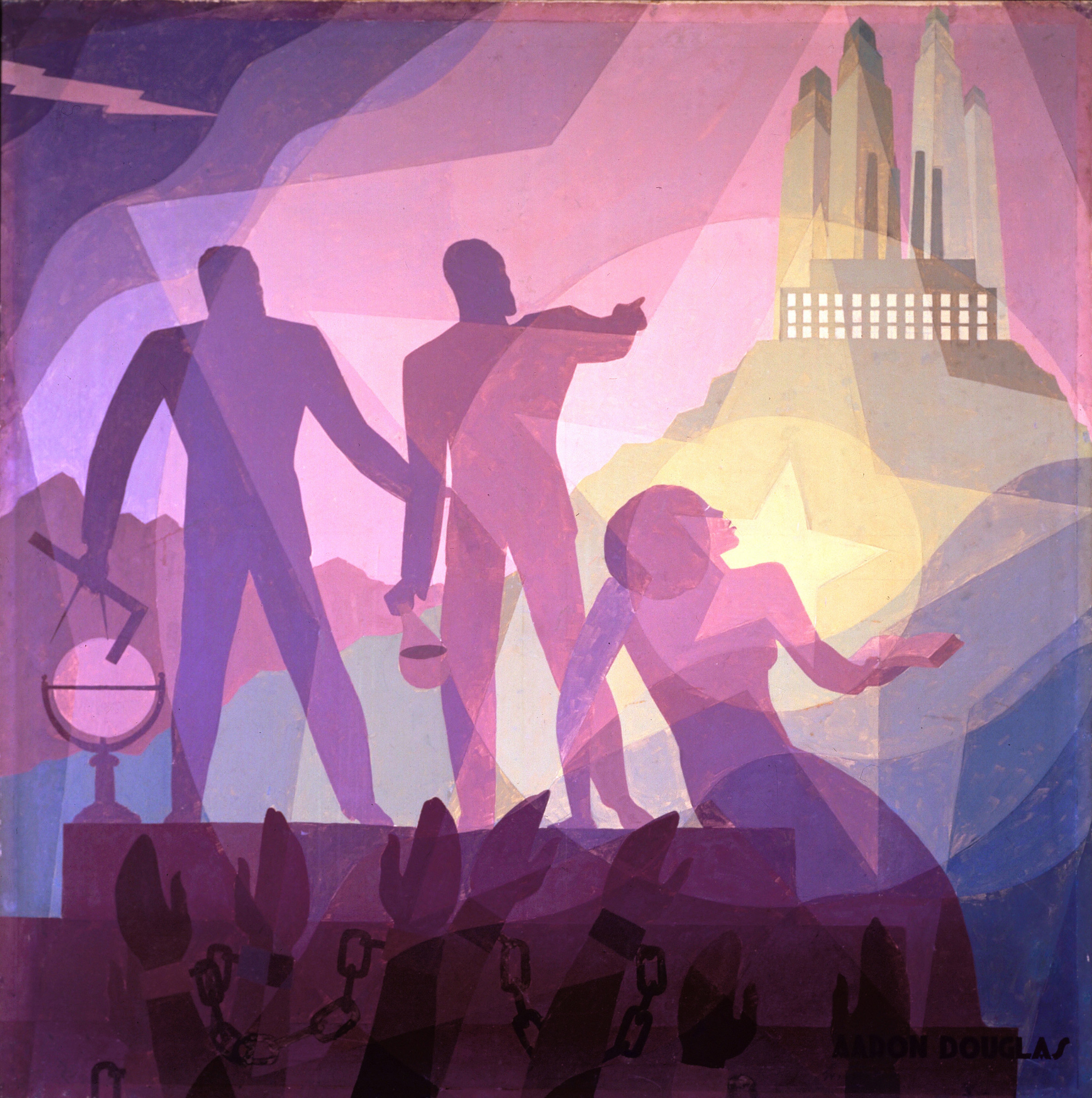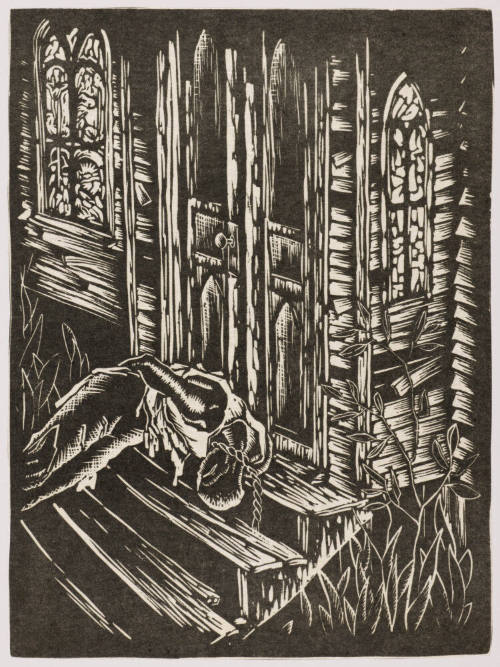Early Modern Art Blog
The Harlem Renaissance
The Creation (1927) Illustration by Aaron Douglas, based on the written work of James Weldon Johnson (1871-1938), "God's Trombones: Seven Negro Sermons in Verse."
The Harlem Renaissance was unlike any other movement in American history. During its time, participants referred to this movement as "The New Negro," the term originating from the title of Alain Locke's work from 1925. After the Civil War, many African Americans moved north to pursue a new life. There was a sizeable cultural boom in the neighborhood of Harlem in New York City. This movement spread and bred the works of artists like Aaron Douglas, Hale Woodruff, and Archibald John Motley Jr. Along with them came other artists, musicians, photographers, and writers who created the first African American movement of modern art. These creations show diversity in stories, craft, emotions, and expressions of life, religion, and post-civil-rights political and civil tensions. In this modern art movement comes the display of educated, diverse, hard-working, and talented artists who helped rebrand African Americans post-WWI. Having fought alongside fellow Americans in the war, they shared the sentiment of wanting to achieve the American dream much like anyone else. This movement fostered a representation and appreciation for African heritage, to which many works in this era are attributed. Representation and fellowship of black and white artists alike come together and meld their artistic worlds, pushing a narrative of comradery among these communities later in the movement.- The image depicts three prominent figures as the central focal point, with arms bound in chains behind them and an industrialized city on the hill in front of them.
- We have a geographist, a scientist, and an academic looking toward the city on the hill, each raising their right hand toward the city, gesturing to its beauty and wonder.
- The bright contrast of the star creates a focal point of light; the lines also carry our focus across the canvas to view other important information shown in the imagery.
- It stylizes the American dream, leaving the darkened chains in the past to work towards a much brighter future.
- The lines from the star display the cultural contributions of Egyptian and African pyramids and civilizations. The waves represent the trans-Atlantic crossing of slave ships to the Americas (FAMSF).
- I love the color choices for this piece and the overall message. The darker colors become washed away by wave-like lines and images from the left of the painting, while the sharp lines and brightness of the star radiating through the image force our attention up and above those waves/hills, the buildings clad in the same yellow/golden light.
- "Holy shit" were the first words out of my mouth once I realized the subject of this image.
- The stark black-and-white contrast in the imagery boldens the message of this piece while also showing the emotional weight and darkness of the image.
- The broken-down state of the church building with overgrown grasses depicts a community or neighborhood abandoned by greater society.
- The deceased is in a position that shows disregard for humanity, having treated the body like mere garbage or a package to be delivered.
- The state of the individual's clothes is shredded and torn, showing signs of abuse or ravaging.
- Important message regarding political and civil unrest between black and white communities displays the prominence of lynchings that still exist after the Civil War.
- The harsh/bold lines in the image create a very contrasting light and shadow effect, displaying the details in a heightened manner.
- While incredibly sad, this image is devastatingly vital for historical purposes, and I sincerely appreciate its message. I often wonder how difficult it was to create a piece like this.
- Creativity, improvisation, and the popularity of dancing are displayed throughout the image, with people filling the floor surrounding the bar.
- Jazz culture was very enthusiastic, vibrant, and carefree. The movement in this piece is inspired by the bump, rhythm, and flow of the jazz styles popularized during this time.
- This piece largely contributes to the movement of paintings modeling the average lives of black people during this time.
- Serves as a representation of the lively social structure held in the black community.
- There is a connection between multiple individuals throughout the piece and the energy produced through the lines that keep the viewer's eyes moving up and to the left corner.
- Motley captures micro-social transactions across several groups in this piece, all clad in the same dim, magenta, and purple hue, giving the feeling of bar lighting.
Resources:
"Aaron Douglas." National Gallery of Art, www.nga.gov/collection/artist-info.38654.html. Accessed 24 July 2024.
"Aspiration." FAMSF, www.famsf.org/artworks/aspiration. Accessed 24 July 2024.
By Parties Unknown, The Nelson-Atkins Museum of Art, art.nelson-atkins.org/objects/68770/by-parties-unknown. Accessed 24 July 2024.
"Exhibition Tour - The Harlem Renaissance and Transatlantic Modernism | Met Exhibitions." YouTube, The Metropolitan Museum of Art, 8 Mar. 2024, www.youtube.com/watch?v=O5vZ-x5G0Zs.
Harlem Renaissance, National Gallery of Art, www.nga.gov/learn/teachers/lessons-activities/uncovering-america/harlem-renaissance.html. Accessed 24 July 2024.
Johnson, James Weldon. "God's Trombones: Seven Negro Sermons in Verse: Electronic Edition." Documenting The American South, docsouth.unc.edu/southlit/johnson/johnson.html. Accessed 24 July 2024.
"Nightlife." The Art Institute of Chicago, Arts of the Americas, www.artic.edu/artworks/117266/nightlife. Accessed 24 July 2024.
"Teaching Guide: Aaron Douglas, Aspiration." Smarthistory, Smarthistory, smarthistory.org/seeing-america-2/social-structures/teaching-guide-douglass-aspiration/. Accessed 24 July 2024.




The third to the last one looks marvelous. I don't really care for the other ones. I appreciate the use of stark lines and high contrast. It's monochromatic which is something I tend to favor. I like how the way the lines are it isn't immediately clear what you are looking at. It's like a mystery for the eyes. Because when you first look at the jagged lines it doesn't make sense as to what you are looking at. Then you make out a window, a wall, steps, and a body. It's almost like you have to do a forensic investigation with your eyes to figure out what it is. That's how the artist draws you into the picture. That's a really creative approach. Most of the other ones I have seen use geometry, triangles, ovals, circles, or other little circuits for your eyes to run along the work. In this case, the artist forgoes that and instead uses kind of confusing lines to distort the image so that the onlooker has to decipher whats there. It's pretty clever. I don't know if I would have connected the dots on a dead dude, with a noose on what is a presumably a church as being some commentary on racism. Now that I am typing it I am but I wasn't really picking up on that before. I could see that having a dead black person on a church steps as harkening back to when lynching's were common. It might have been something they witnessed, or maybe they are trying to express some generational trauma. Perhaps that's part of the drawing the viewer in appeal.
ReplyDeleteHi Mars! OMG I loved the pieces you chose and how you perceived them. The By Parties Unknown piece was the most appealing as I really had to take a close look to make out the art. And once you began describing it, I can see it and its beauty and emotions. It is a very beautiful piece as it not only is great art but also a great and deep meaning behind it, and that kind of art is most appealing in my opinion. Racism during the early modern times were definitely a hard one as it was so heartbreaking and prejudice, so I enjoyed that you touched on that with your pieces you chose. Overall I enjoyed your blog and how you outline your posts and I appreciate how you digest the whole piece from art elements to the meaning.
ReplyDelete